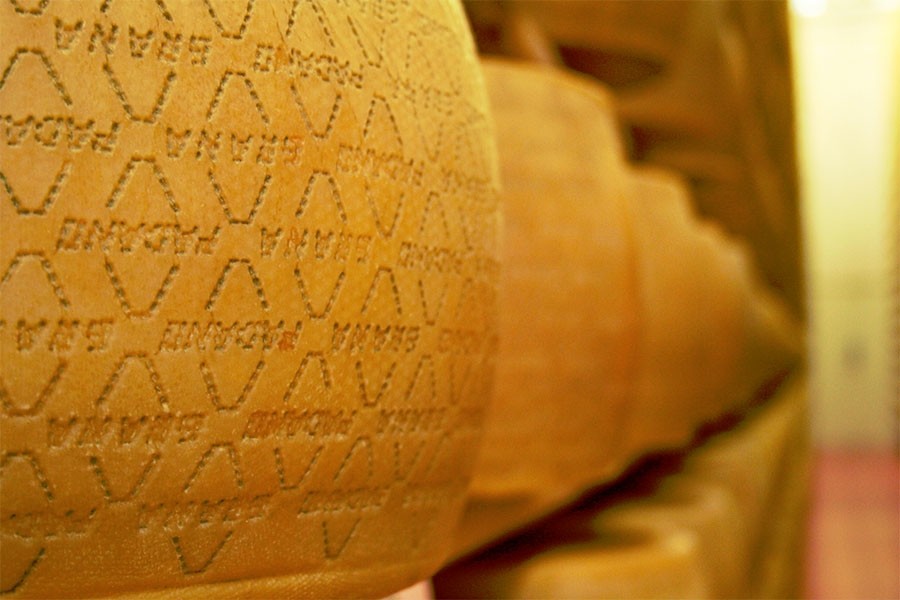Grana Padano Cheese P.D.O.
Product description
Grana Padano PDO is a hard cooked cheese that undergoes a slow ripening process.
It is produced from raw cow’s milk originating from cows that are milked no more than twice a day, and which are fed with green or preserved fodder from the production area.
Production method
The milk is partially skimmed through the natural separation of the cream, at a temperature of 8-20°C.
The milk is then put into copper or copper-lined boilers with a characteristic upside down bell-shape.
A natural whey starter is added and the milk, heated to a temperature of 31-33 C°, curdles with the addition of calf rennet.
The curd is broken with a curd knife before starting the agitation and cooking process, which is terminated when the temperature reaches 53-56°C.
The cheese mass settles on the bottom of the boiler and is left to rest for a maximum of 70 minutes, during which time it firms up and the whey is expelled.
It is then lifted from the boiler with the aid of a wooden shovel and towel (schiavino), and cut into two equal parts, the so-called forme gemelle (twin wheels).
Each part is wrapped in a linen cloth and removed from the boiler onto the finishing table.
The forms are placed in molds for at least 48 hours, which imprint the cheese with the marks of origin; this is followed by brining for 14 to 30 days.
After the rounds have been dried in the so-called hot room or in heated areas, they are left to ripen for a minimum of 9 months to over 20.
At the end of the eighth month, the cheese is submitted to a series of product tests, after which it is fire-branded,
or if the cheese does not possess the obligatory characteristics specified in the product specification, the marks of origin imprinted by the mold are removed by “shaving”.
Apparence and flavour
Grana Padano PDO is cylindrical and has a thick smooth rind with a dark to natural golden-yellow colour.
The cheese is fine-grained and ranges from white to straw yellow in colour, with barely visible eyes.
The aroma is fragrant and it has a delicate flavour.
Gastronomy
Grana Padano PDO is used either as a table cheese or as an ingredient in traditional Italian dishes, depending on how mature it is.
It should be conserved in the least cold compartment of the fridge, wrapped in a moist cloth or plastic wrap.
Marketing
The product is marketed in the following typologies: Grana Padano PDO; Grana Padano PDO Over 16 Months; Grana Padano PDO Riserva Over 20 Months; Grana Padano PDO Trentingrana.
The brand mark must appear on all packets of grated and portioned cheese. Packaging must take place in the same production area.
Distinctive features
Grana Padano PDO meets the needs of a balanced and modern diet.
Its easy digestibility and the excellent relationship between energetic value, quality and quantity of nutrients, makes this cheese particularly indicated for newborns, sportspersons, the elderly and pregnant or breastfeeding women.
History
The origins of Grana Padano PDO date back around 1000 A.D., when the Cistercian monks experimented with hard cheese production, caseus vetus (later named grana).
At the end of the XI century, this cheese was already an established product with its own commercial network.
Production area
The production area of Grana Padano PDO is within the territory of the provinces of Alessandria, Asti, Biella, Cuneo, Novara, Turin, Verbania-Cusio-Ossola and Vercelli in the Piedmont region; within the provinces of Bergamo, Brescia, Como, Cremona, Lecco, Lodi, Mantua (left of the River Po), Milan, Monza, Pavia, Sondrio and Varese in the Lombardy region; within the Province of Trento, as well as the municipal areas of Anterivo, Lauregno, Proves, Senale-S. Felice and Trodena in the Province of Bolzano, in the Trentino-Alto Adige region; within the provinces of Padua, Rovigo, Treviso, Venice, Verona and Vicenza in the Veneto region; in the Province of Bologna (right of the River Reno), Ferrara, Forlì, Cesena, Piacenza, Ravenna and Rimini in the Emilia-Romagna region.
Operators: 4.688
Production(KG): 169.138.000
Turnove(MLN€): 1415,30

 IT
IT 